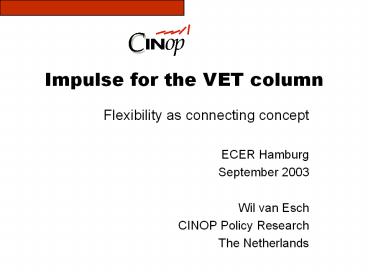Impulse for the VET column PowerPoint PPT Presentation
1 / 22
Title: Impulse for the VET column
1
Impulse for the VET column
- Flexibility as connecting concept
- ECER Hamburg
- September 2003
- Wil van Esch
- CINOP Policy Research
- The Netherlands
2
On the way to the knowledge society
- Industrial
- Standard programs
- Distinction head-hands
- Knowledge and skills more or less closed
- Education and training in one institution
- Differences between students deviation of the
standard - Vertical hierarchy
- Knowledge
- Individual learning trajectories
- Head-hands-heart integrated by competences
- Knowledge and skills stream
- Open learning environments
- Differences are the starting point
- Horizontal organisation
3
Needed changes in present VET-system
- Opening of a second royal route to higher
education - Removal of partitions between the parts of VET
(prevocational-secondary vocational-higher
vocational) - Activation of hidden and wasted talent
- Raising responsivity
- Raising attractiveness VET through career
building - Strengthening tailor-made trainings
- Raising external orientation of educational
institutions - Raising professionality
4
Impulse regulation
- Aim realisation qualification profit
- Two tracks innovation of contents and
institutions - Regulations for 2000 en 2001, continuation for
2002-2005 - Distribution prevocational-secondary
vocational-higher vocational 321 - For 2002-2005 2 monitors qualitative and
quantitative
5
Themes education institutions
- Career orientation and guidance
- Programmatic connection
- VET-specific pedagogy and didactic
- Knowledge infrastructure
6
Themes Lead bodies
- Improving connection qualification structure
secondary vocational education with prevocational
and higher VET - Strengthening the quality of work-based learning
- Development of a competence-based qualification
structure
7
Definition of flexibility
- All activities meant to optimalize the adjusting
and specification to characteristics and needs of
students and clients of prevocational, secondary
vocational and higher vocational education and
training
8
Figure The wheel of flexibility
Administrative -legal
Organisational and environment
Competence-based VET
Program and curriculum
Professional
Pedadogic- didactic
9
Administrative-legal flexibility
- Commission-Boekhoud no central attention
- Important condition for successful implementation
10
Organisational and environmental flexibility
- Is Impulse concept central part of strategic
policy? - Is Impulse concept translated into operational
policy? - Are the Impulse incentives put into action with
the focus on strengthening the concept of career
building and the transition within VET? - Is the environmental potential (schools, trade
and business, lead bodies, others) used as a
source for the realisation of the Impulse
concept? - Do the lead bodies promote the transition within
VET?
11
Flexibility of programs and curriculum
- Are training programs constructed taking into
account the wishes and needs of students and
clients (trade and business)? - Are there connections between attainment goals of
the parts of the VET-column? - What do these connections look like
(comparison-integration)? - Are there connections between the parts
concerning work-based learning? - Are there possibilities for flexible access,
flexible transfer en flexible testing?
12
Pedagogic-didactic flexibility
- Is there competence-based learning and training
VET-wide? - Is there a competence-based education approach
VET-wide? - Is there a longitudinal career building?
13
Professional flexibility
- Is professionalism aimed at strengthening the
career and column concept a central part of the
professionalism policy of VET-institutions and
Lead bodies? - Are there connections between the parts within
VET concerning this professionalism?
14
Results concerning environmental flexibility
- Impulse regulation has stimulated the cooperation
between VET-institutions and between these and
other institutions in the region - The cooperation with trade and business though is
very difficult - Cooperation mostly bilateral
- The cooperation is concentrated at the transition
prevocational-secondary VET and less at secondary
VET-higher education. Higher VET is mainly
directed at general secondary education - Cooperation mainly at strategic level
15
(No Transcript)
16
Results concerning organisational flexibility
- The Impulse concept is mostly part of the
strategic policy of institutions - There are big differences between the
stage-management - The approach of radical innovations (such as
integrated, longitudinal learning trajectories)
is by way of pilots - Often here the greatest bottlenecks engaging
personnel difficult because of the late
publication of the regulation, priority at
primary process, difficult to arrange
substitution of personnel
17
Results concerning programmatic and curricular
flexibility
- In terms of the innovation cycle most activities
are in the stage of development a lot is sowed,
harvesting still has to begin - Reconstruction of programs and curricula from a
competence-based angle - Enormous variety from orientation and exploring
to completely integrated, longitudinal learning
trajectories - Most qualification profit to be reached at
trainings which have a lot in common
18
(No Transcript)
19
Results concerning pedagogic-didactic flexibility
- Here too mostly in the initial stage
- There is a longer tradition
- Here and there successful implementation
- Longitudinal apprenticeship and work-based
learning very rarely
20
(No Transcript)
21
(No Transcript)
22
Stimulating and impeding factors
- Stimulating factors
- Sharing of knowledge through cooperation and
networking - Clear frameworks
- Bottom up approach
- Adequate organisational and financial conditions
- Adequate project management
- Linking up with running innovations
- Looking for regional nearness
- Culturel aspects
- Impeding factors
- Law and regulations
- Image forming
- Relation with trade and business more difficult
in economic heavier times - Complexity in content and regional complexity
- Complexity of broad, multilateral networks of
cooperation

